Tools Used For Database Design
We are reader supported and may receive a commission when you make purchases using the links on our site
8 Best Database Diagram Tools
Once databases exceed human-digestible sizes, using graphical tools to assist in their design becomes essential. We'll show you the best database diagram tools to give you the edge.
UPDATED: December 7, 2020
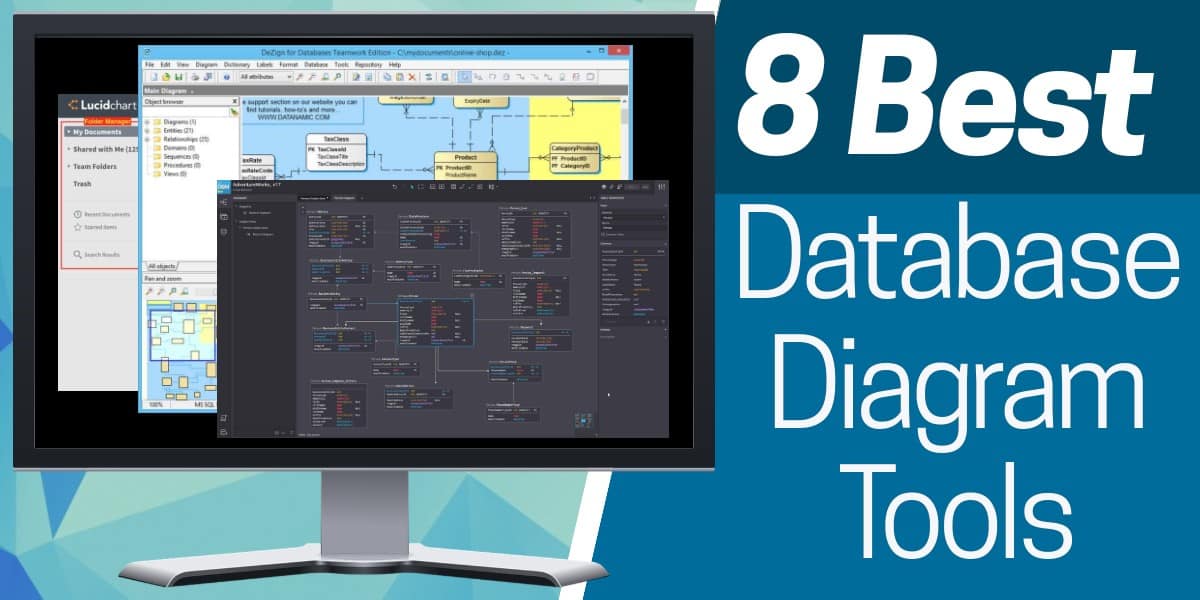
Creating databases sounds like a complex process but with modern database diagram tools, this isn't the case.
There are plenty of software products that enable users to create and import database diagrams to view relationships between database objects.
Here is our list of the eight best database diagram tools:
- Lucidchart Online database diagram tool with data visualization and collaboration features.
- DeZign Database modeler and diagram tool with synchronization capabilities.
- SqlDBM Online Database diagram tool with forward and reverse engineering so you can import from an existing database.
- dBForge Studio for SQL Server A database diagram tool for SQL Server that has a visual designer tool and schema synchronization.
- DbDesigner Online database diagram tool and modeling tool for MySQL, SQL Server, PostgreSQL, Oracle, and SQLite.
- DbSchema Database diagram and schema synchronization for SQL and NoSQL databases.
- SmartDraw Database diagram tool that acts as an alternative to Microsoft Visio with Intelligent Formatting and content templates.
- Navicat Data Modeler Database diagram MySQL, Oracle, MariaDB, SQL Server, PostgreSQL, and SQLite.
The best database diagram tools
1. Lucidchart
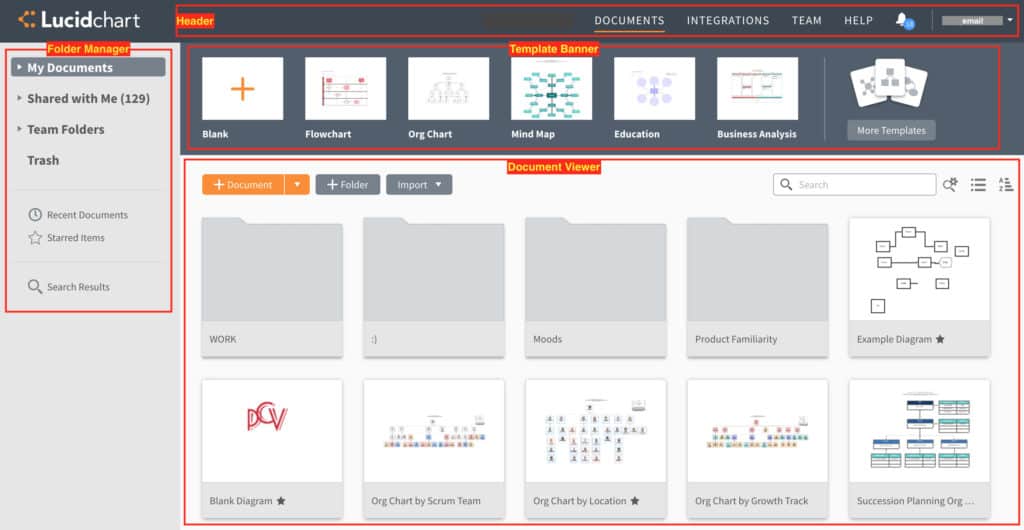
Lucidchart is a visual database design tool that allows you to automatically create, edit, and import database diagrams. The software is compatible with databases such as MySQL, PostgreSQL, Oracle, and SQL Server. You can select from a library of shapes to build a new database.
Once you've finished diagraming your database you can export it to your DBMS. Alternatively, you can publish and share it with other members of your team through another integrated service. Lucidchart has integrations for Google, Dropbox, box, Jive, Okta, one login, Microsoft Office, Microsoft Azure, Slack, HipChat, JIRA, and more.
There are four versions of Lucidchart: Free, Pro, Team, and Enterprise. The Free version is free for a single user. The Pro version costs $9.95 (£7.68) per month paid annually or $11.95 (£9.23) for one month and includes unlimited documents/shapes.
The Team version starts at $27 (£20.85) per month for three users. The Enterprise version carries a custom price tag and adds features like centralized admin control and document retention. You can sign up for a free trial.
2. DeZign
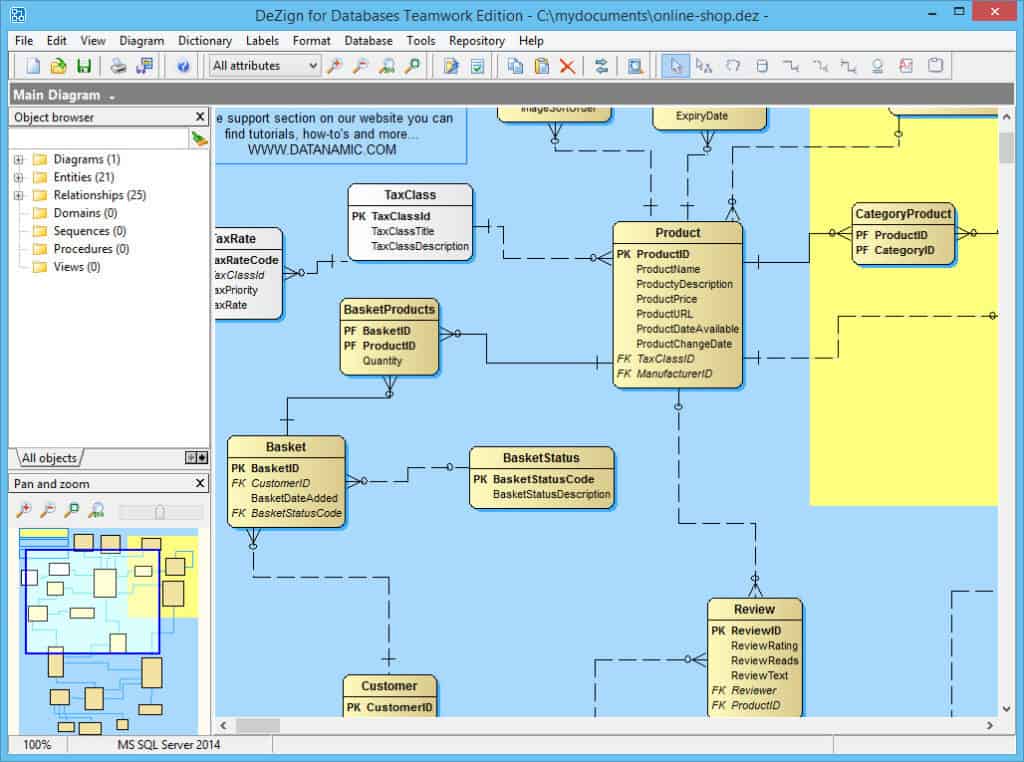
DeZign is a data modeling and database diagram tool that enables the user to create and model databases. The tool automatically generates diagrams for popular databases. The tool uses entity-relationship diagrams to display the relationships between database entities. The database diagram editor is drag-and-drop so you can object elements easily.
If you need to pass your databases on you can create customized reports and export them in PDF, Word, and HTML formats. You can also export diagrams as images in png, jpeg-image, bitmap, gif-image, and Windows metafile.
There are four versions of DeZign available to purchase: Standard, Professional, Expert, and All Products Pack. The Standard version costs $10 (£7.72) per month on an annual plan. The Professional version costs $32 (£24.71) per month annually with the ability to reverse-engineer existing databases.
The Expert version costs $43 (£33) per month with additional features for collaboration and the option to update databases from a model. The All Products pack costs $88 (£67) per month and includes access to a range of other products including Datanamic SchemaDiff Professional. You can download the 14-day free trial.
3. SqlDBM
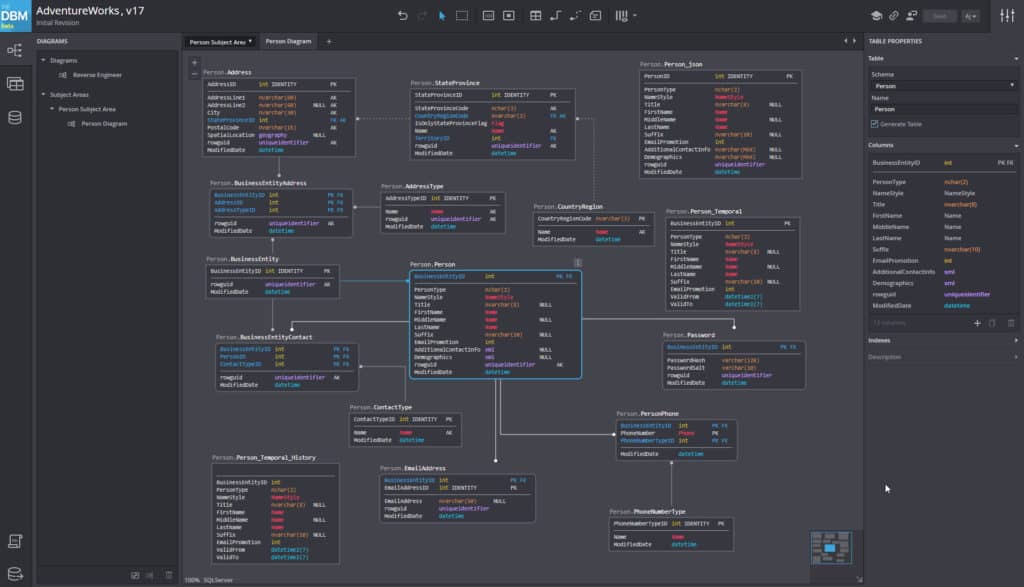
SqlDBM is an SQL diagram tool and database modeler that you can use to create and import databases. SqlDBM is compatible with SQL Server, MySQL, PostgreSQL, Snowflake, and Amazon Redshift. You can create database objects such as tables, objects, and relationships through the intuitive GUI (which is available in dark and light themes).
One of the most useful features offered by the GUI is View Modes. View Modes allow you to change the perspective of your databases and choose which elements you see on the screen. For example, Table Names only and Keys only options enable you to prioritize monitoring particular elements.
To support collaboration, SqlDBM allows you to share diagrams and changes with other users with a URL. Just copy and paste the link into an email and your team will be able to click through to your diagram. All versions of your diagrams are saved in the cloud so if you ever need to revert to an earlier version you can do this.
There are three versions of the program available: Free, Single Unlimited, and Team Unlimited. The Free version supports one active project at a time. Single Unlimited costs $15 (£11.58) per month for unlimited projects and revisions. Team Unlimited comes with three licenses and costs $45 (£34.75) per month. You can test out the online sample of SqlDBM from this link here.
4. dBForge Studio for SQL Server
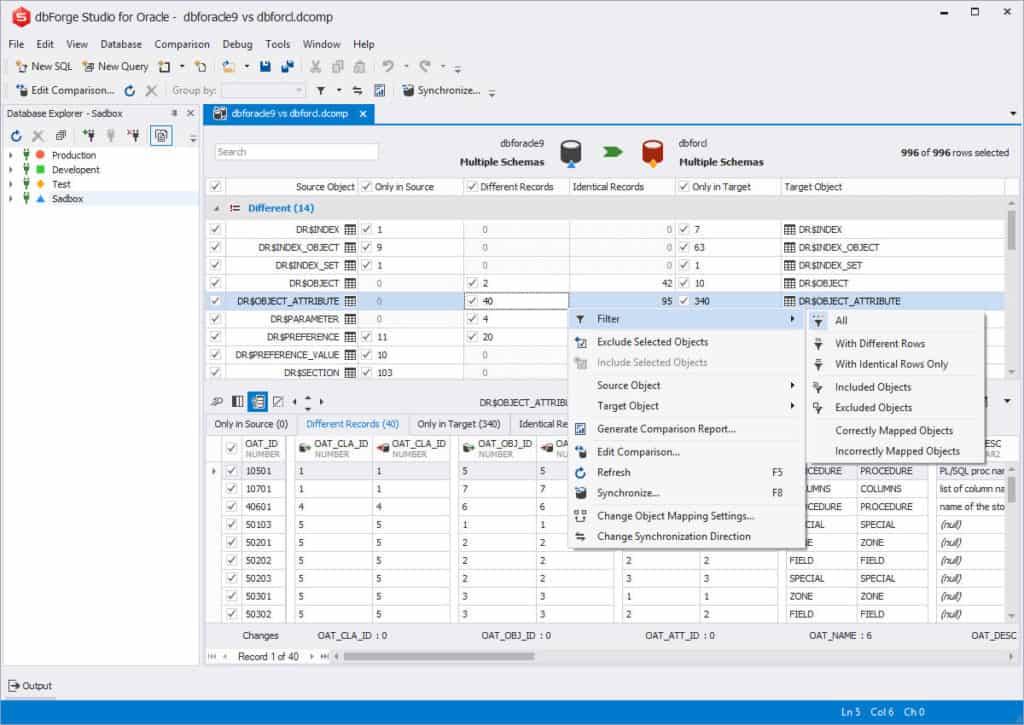
dBForge Studio for SQL Server is an SQL management tool with diagram capabilities. The user can create diagrams of a database from the Data Explorer with drag-and-drop. The container feature allows the user to store objects that are logically related in one place. The user places tables inside a container then minimizes it. Containers are ideal for those companies working with large databases
The platform also offers the ability to manage logical relations between database tables through the Virtual Relation Manager. The manager allows the user to view visual displays of logical relations and edit them. The user can then use these virtual relations to generate schema scripts based upon selected table relations.
Once you've finished designing your diagram you can print it. You have complete control over the layout of your printouts through a range of page settings. Page settings you can adjust include page orientation, paper size and source, header and footer, printing margins, and more.
There are three versions of the software available to purchase: Standard, Professional, and Enterprise. The Standard version costs $249.95 (£193) and includes features like code completion. The Professional version costs $499.95 (£386.07) with data compare and sync functions. The Enterprise version costs $699.95 (£540) with DB Documentation and Source Control. You can download the free trial version.
5. DbDesigner
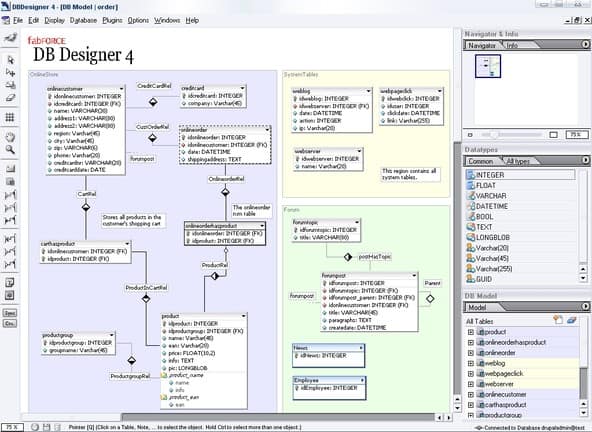
DbDesigner is an online visual database design tool with reverse and forward engineering capabilities. You can import an existing database from MySQL, PostgreSQL, and Oracle or export for MySQL, MS SQL, PostgreSQL, Oracle, and SQLite. Databases can be exported in PDF and PNG formats. The tool is very user-friendly with a mini-map and keyboard shortcuts to help the user navigate.
The tool has several features that support collaborative environments. Users can share links to database diagrams and assign access levels: Owner, Editor, and Viewer. You can also manage projects through the dashboard where you can open or delete projects. There is the option to view a version history of projects to keep track of any changes made.
There are three Individual Plans available to purchase: Starter, Basic, and Unlimited. The Starter version is free and supports two database models with 10 tables per model. The Basic version costs $5 (£3.86) per month with 5 database models and 25 tables per model.
The Unlimited version costs $15 (£11.58) per month with unlimited models and unlimited tables. You can start the free trial.
6. DbSchema

DbSchema is a database documentation and management tool for developers of SQL, NoSQL, MongoDB, and Cloud databases. It has an interactive layout feature that lets you design databases with diagrams. Elements like tables and foreign keys can be dragged and dropped onto the canvas. You can also create multiple layouts for different parts of the database schema. When you've finalized the diagram of the database you can print it in PDF or HTML5.
For MongoDB users, in particular, DbSchema offers a range of features including reverse engineering. You can reverse engineer schemas of other external databases. In addition, DBSchema has a Query Editor where the user can query the database. There is also a database visual query builder so the user can build queries in a visual format as well.
The schema synchronization feature is also great for environments where you want to apply the schema to multiple databases. The synchronization process highlights the differences between projects and databases. You can also share the Schema project with your team to collaborate on changes.
There are three versions of DbSchema available to purchase: Academic, Personal, and Commercial. The Academic license costs $63 (£48) for educational institutions. The Personal version is $127 (£98) for a single-user who can use the license on multiple computers. The Commercial version costs $197 (£152) for companies with support for one developer or administrator. You can download the 15-day free trial.
7. SmartDraw
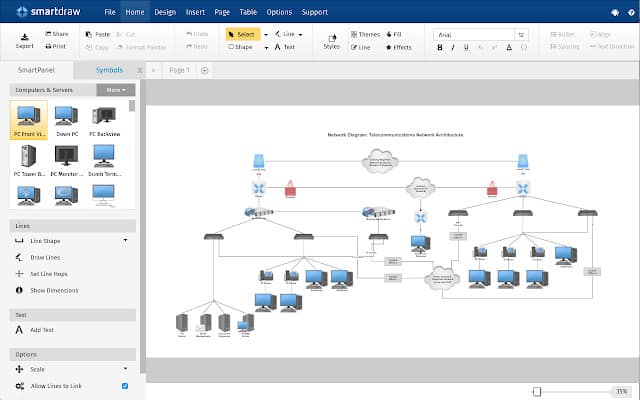
SmartDraw is a web-based diagram tool that allows you to automatically create your diagrams of databases. All you need to generate the diagram is to export a CSV file. Once the database has been created you can edit it through drag-and-drop. The diagram design function has intelligent formatting so that diagrams will be automatically adjusted when you edit, add, or delete a shape.
To further help new users use the program there are customizable diagram templates so you can build your diagram efficiently. There are over 34,000 different symbols to choose from.
Accessibility is something that SmartDraw does very well. There is a range of integrations with other tools such as Microsoft Office, G Suite, Confluence, and Jira so you can manage databases however you see fit. You can also import or export diagrams to and from Microsoft Visio.
There is a Single User version of SmartDraw and a Multiple Users version. The Single User version costs $9.95 (£7.68) per month and comes with over 4,500 templates. The Multiple User version costs $5.95 (£4.59) for five+ users with additional features like administration controls account consolidation. You can sign up to try SmartDraw from this link here.
8. Navicat Data Modeler
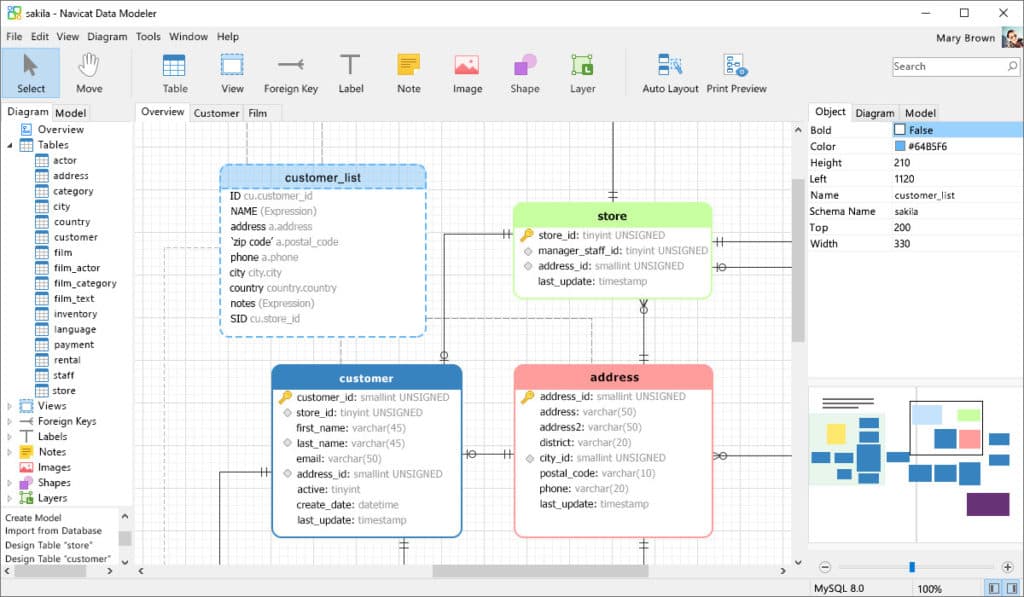
Navicat Data Modeler is a database diagram creation tool with support for MySQL, Oracle, MariaDB, PostgreSQL, and SQLite. You can create and edit database models without needing to write SQL scripts. However, there is SQL Code Generation if you do want to generate SQL script.
Reverse engineering allows you to import existing database structures into the program. You can keep track of database changes with the Synchronize to Database function. After comparing the differences between your model and the database you can use synchronization to update the database.
Navicat is available for Windows, Mac OS, and Linux. The Enterprise version of Navicat Data Modeler has three payment options: Monthly Subscription, Yearly Subscription, and Perpetual License.
The Monthly Subscription is $22.99 (£17.75) per month. The Yearly Subscription costs $229.99 (£177.54) per year. The Perpetual license costs $459 (£354.32) per license. You can download a 14-day free trial.
Choosing a database diagram tool
Creating databases through diagrams is the simplest way to create a database. You don't need any coding knowledge to drag shapes into place to visualize database structures. With tools that can import data from external databases, creating diagrams is easier than ever before.
Visual database tools like Lucidchart, DbForge Studio for SQL Server, and DbDesigner are all top-tier platforms for managing database diagrams. If you need multiple users to work on diagrams then adopting a tool with collaboration capabilities is a must.
Database Diagram Software FAQs
How do you create a relational database schema?
- Define the purpose and boundary of the database
- Gather all data labels for the system
- Group the labels by type
- Open an ERD diagrammer
- Create an entity for each group
- Create attributes within each entity and name it with the relevant data label
- Identify candidate keys in each group
- Find a unique key – if none exists generate an attribute
- Normalize the groups so that each attribute in a group is dependent on the key, the whole key, and nothing but the key.
- Connect entities together with relationships
- Add foreign keys to entities where necessary
- If any many-to-many relationships exist, create an intermediate Entity to break that relationship down
How do you draw relationships in a database?
A relationship is shown in an ERD as a line between two entities. There should be one attribute in one table, called a foreign key, that will contain values that match those in the primary key of another entity. The relationship line links those two attributes together. This is a one-to-many relationship and that should be shown with a V drawn around the connection to the foreign key, which is called a "crow's foot" and looks like a fork with the three prongs attaching to the side of the entity.
What are the four stages of designing a database>
The four stages of database design are:
- Conceptual Design – Name the purpose of the database and its boundaries.
- Logical Design – Build an ERD by collecting all data identities, grouping them into entities, and linking entities with relationships.
- Data Normalization – This is the process by which the ERD is refined. Make sure that each entity has a unique key, that every attribute in each entity is entirely and only dependent on the primary key, and that there are no many-to-many relationships.
- Physical Design – Translate the ERD into database objects.
Tools Used For Database Design
Source: https://www.comparitech.com/net-admin/best-database-diagram-tools/
Posted by: elliottlizintacer1944.blogspot.com

0 Response to "Tools Used For Database Design"
Post a Comment